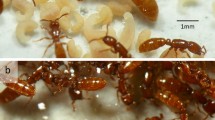Summary:
Though harvester ants are closely similar in ecology, species differ in their worker size polymorphism as well as in the glandular source of their trail pheromones and defensive compounds. In the harvester ant Messor barbarus, we find that the recruitment trail pheromone is located in the Dufour gland, while defence-alarm substances are produced in the poison gland. We also investigated how the glandular development and the ethological response to these abdominal glands are related to worker body size. For both glands, M. barbarus workers show monophasic and nonisometric growths with slopes of allometric regression lines lower than 1. The highest trail-following response is elicited by the Dufour gland secretion from media workers, responsible for most foraging activities in M. barbarus. Aggressive behaviour is more frequently observed in the presence of poison gland secretions from medium and large-sized workers. Differences between species and between worker size classes in the ethological role of sting associated glands are discussed in relation to the foraging ecology and defensive characteristics of harvester ants.
Similar content being viewed by others
Author information
Authors and Affiliations
Additional information
Received 20 June 2000; revised 7 September 2000; accepted 12 September 2000.
Rights and permissions
About this article
Cite this article
Heredia, A., Detrain, C. Worker size polymorphism and ethological role of sting associated glands in the harvester ant Messor barbarus. Insectes soc. 47, 383–389 (2000). https://doi.org/10.1007/PL00001735
Issue Date:
DOI: https://doi.org/10.1007/PL00001735




